The Role of Digital Access Management in Modern Real Estate Solutions
- December 12
- 10 min

Interactive sales solutions for real estate are reshaping property marketing by giving agents and developers advanced ways to connect with clients. With real estate technology tools like virtual tours, interactive floor plans, and automated lead capture, the industry is seeing strong demand for platforms that make property sales more engaging and efficient. As competition increases, customization in real estate sales solutions stands out as a key factor that helps businesses meet unique client needs and deliver a more vibrant experience.
Key takeaways:
Interactive Sales Solutions in real estate are technology-driven platforms and tools designed to enhance property marketing and streamline sales processes. They use features such as virtual property viewing, 3D modeling, augmented reality (AR), real-time communication, and data integration with CRM systems. These solutions cater to modern buyers who expect digitally-enhanced experiences and empower businesses by improving efficiency and engagement.
Unlike traditional approaches that rely on static photos or in-person walkthroughs, interactive solutions bring properties to life. They allow buyers to explore every corner of a listing, customize layouts, or visualize design changes in real-time.
For example, a 3D walkthrough enables a prospective buyer to “step inside” a home without leaving their couch. A seller may use augmented reality to show what an unfurnished property would look like with furniture styles tailored to their buyer’s preferences. They tell a story while providing a space for individual exploration, fostering emotional connections between buyers and properties.
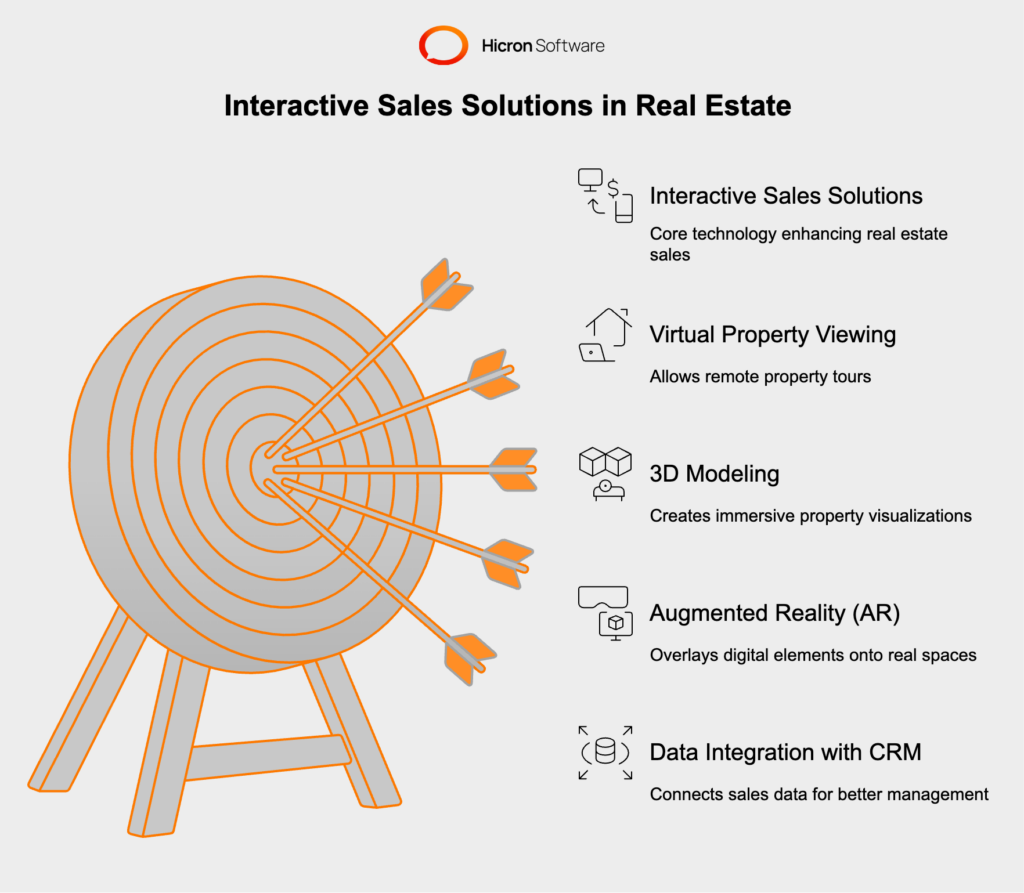
The real estate industry is being transformed by technology, and interactive sales solutions are leading the way. These advanced tools are designed to enhance how properties are marketed and sold, giving buyers and agents alike a better, faster, and smarter experience. Here’s a breakdown of the key benefits these solutions provide.
|
Benefit |
Description |
Key Features/Examples |
|
Enhanced Buyer Experience |
Interactive sales solutions elevate the buyer experience by bringing properties to life, making them more engaging than traditional methods. |
Real estate virtual tours, 3D walkthroughs, augmented reality customization (furniture or layouts) |
|
Increased Sales Efficiency |
Helps real estate agents streamline repetitive tasks, allowing more time to focus on building client relationships and closing deals faster. |
CRM integration, automated lead management, communication tools (scheduling, follow-ups) |
|
Data-Driven Insights |
Provides detailed buyer behavior analytics to help agents adapt strategies and personalize property marketing efforts. |
Insights on buyer preferences (e.g., room focus, feature appeal, property engagement trends) |
|
Competitive Edge |
Positions firms as industry leaders through innovative, tailored tools that align with buyer expectations and foster trust and loyalty. |
Customizable virtual tours, branded analytics dashboards, tailored buyer experiences |
One of the biggest advantages of interactive sales solutions is how they elevate the buyer experience. Features like real estate virtual tours and 3D walkthroughs bring properties to life, making them far more engaging than traditional methods like photos or descriptions.
Buyers can explore every corner of a property and take a personalized, remote “tour” from the comfort of their own homes. For example, a buyer relocating from across the country can view multiple homes in high definition without traveling, saving time and resources. Tools such as augmented reality can allow users to visualize how properties look with custom layouts or furniture.
This level of immersion helps streamline decision-making. Buyers can form stronger connections to properties through detailed, interactive experiences, often deciding faster which homes are worth an in-person visit.
Interactive sales solutions help real estate agents work smarter. With tools designed to automate repetitive tasks, agents can focus less on administrative work and more on building strong client relationships.
Pairing real estate virtual tours with CRM integrations simplifies lead management. Agents can quickly monitor which properties grab the most attention and prioritize their outreach accordingly. In-built communication tools make it possible to schedule showings, answer buyer questions, and manage follow-ups, all in one platform.
The result is faster sales cycles. By converting qualified leads more efficiently, agents can close deals faster and invest more time in prospecting for new clients.
Understanding what buyers want has never been more important. Real estate analytics embedded within interactive sales solutions provide unparalleled insights. Every click, view, and interaction during a virtual tour helps agents map out buyer preferences and behavior.
For example:
This wealth of information empowers agents to fine-tune their strategy. By presenting properties tailored to buyer interests, agents can craft personalized experiences that are far more effective, leading to higher chances of closing deals. On a larger scale, real estate firms can also use these insights to adjust pricing, marketing campaigns, or even future inventory strategies.
The real estate market is highly competitive, and businesses looking to stand out need to adopt custom real estate solutions. These tailored tools go a step further by elevating a brand’s reputation.
By offering unique features like custom branding on virtual tours or exclusive analytics dashboards, real estate firms can establish themselves as forward-thinking and innovative. Tailored experiences, such as the ability to customize floor plans in virtual listings, go beyond standard offerings, showcasing a company’s dedication to meeting diverse buyer needs.
Advanced solutions in real estate make the entire sales process smoother for agents and support staff, fostering a more efficient business overall. Companies that invest in customized, interactive solutions often position themselves as industry leaders, building long-term trust and loyalty among clients.
Real estate interactive sales solutions are transforming how properties are marketed. They provide advanced tools that cater to modern buyers and enhance sales effectiveness for real estate professionals.
|
Feature |
Description |
Key Benefits/Examples |
|
Virtual Tours and 3D Walkthroughs |
Tools that enable remote property exploration by allowing buyers to view and “walk through” the property virtually from any location. |
Saves time by offering detailed property views before scheduling visits; caters to remote buyers and investors. |
|
Interactive Floor Plans |
Customizable layouts that allow buyers to visualize and adapt property configurations to fit their personal needs and preferences. |
Helps buyers tailor room dimensions, explore configurations, and imagine converting spaces for specific uses. |
|
Augmented Reality (AR) Tools |
Technology that enables buyers to project furniture, experiment with wall colors, or visualize property improvements in real time. |
Boosts buyer confidence by allowing them to personalize spaces; ideal for showcasing design upgrades. |
|
CRM Integration for Real Estate |
Centralized systems that automatically log buyer interactions and preferences to improve lead tracking and follow-ups for real estate agents. |
Enhances communication strategies with personalized follow-ups; ensures no lead is overlooked. |
|
Real-Time Communication |
Features such as chatbots and live video consultations designed to enhance buyer-agent engagement by offering instant responses and interactions. |
Ensures 24/7 support via AI chatbots; live video consultations provide remote buyers with personalized attention. |
Real estate virtual tours and 3D walkthroughs are at the forefront of interactive sales solutions. These tools allow potential buyers to explore every corner of a property remotely. Instead of relying on static images or in-person visits, buyers experience an immersive and interactive exploration that mimics walking through the property at the pace and frequency that suits them.
High-resolution 360-degree tours and 3D layouts make it easy for buyers to virtually
These features save time for both buyers and agents by providing a detailed look at a property before scheduling an in-person visit. Real estate platforms using tools like Matterport have revolutionized how listings are presented, catering to remote buyers and investors who can’t visit properties in person.
When buying a home, one size does not fit all. Interactive floor plans put customization in the hands of potential buyers. These tools allow users to
For instance, a potential buyer can adjust room dimensions, try different furniture placements, or envision converting a guest bedroom into a home office. Interactive floor plans provide buyers with a deeper understanding of how they can personalize a property before purchase, further strengthening their emotional connection to the listing.
Augmented reality tools in real estate sales take the interactive experience to another level. They enable buyers to visualize changes or enhancements to a property in real time. AR allows users to project furniture into empty rooms, experiment with wall colors, or preview renovations, all through their smartphones or tablets.
Picture this: A buyer stands in the living room of a vacant house, opens an AR app, and instantly sees how a stylish sofa, coffee table, and area rug would look in the space. This technology helps buyers imagine themselves living in the property and gives them confidence in their buying decisions.
Augmented reality has also become a powerful tool for showcasing multiple design options or upgrades, particularly useful for properties under construction or newly built homes.
Customer Relationship Management (CRM) integration is a vital feature of interactive sales solutions, ensuring that real estate professionals can effectively manage leads and streamline client interactions. By connecting sales tools to CRM platforms like Salesforce, HubSpot, or Zoho, buyers’ interactions and preferences are automatically logged and organized.
For instance, when a buyer engages with a virtual tour, their data such as how long they spent viewing specific areas can be recorded in the CRM. This allows agents to tailor follow-up communication, whether by highlighting similar listings or answering specific inquiries. Automated lead nurturing ensures no potential client falls through the cracks, keeping pipelines organized and efficient.
Ultimately, CRM integration provides agents with a centralized hub for tracking buyer activity, improving communication, and increasing conversion opportunities.
Effective communication is critical in real estate, and real-time communication tools are designed to enhance engagement between buyers and agents. Chatbots and live video consultations are two standout features that bridge the gap between inquiries and action.
By reducing delays and promoting constant interaction, real-time communication tools ensure that buyers receive the support they need at every step of the purchasing process.
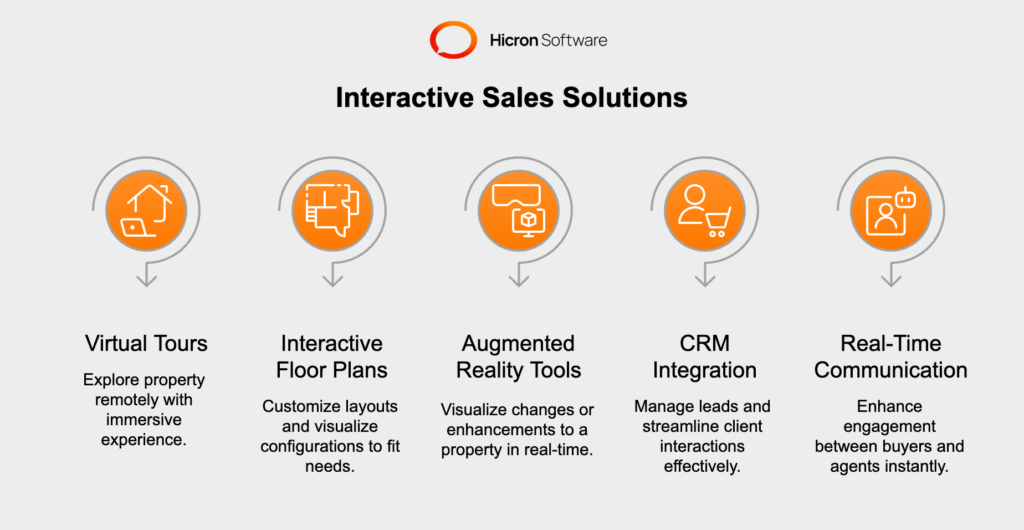
From virtual tours that offer unparalleled immersion to cutting-edge AR tools, interactive sales solutions are revolutionizing real estate marketing. Features like customizable floor plans, CRM integration, and instant communication tools empower buyers to make informed decisions while helping agents work more efficiently. By incorporating these innovative technologies, real estate professionals can elevate their business strategies and provide exceptional value to clients.
Efficient lead capturing and robust system integration are at the core of any successful real estate sales strategy. Interactive sales solutions not only enhance the buyer experience but also help real estate professionals track, nurture, and convert leads with precision. Here’s how advanced lead capturing features, real estate CRM platforms integration, and complementary system integrations are optimizing the real estate business.
Modern buyers often demand convenience and instant results, and leading-edge real estate businesses deliver through advanced lead-capturing capabilities embedded within real estate virtual tours.
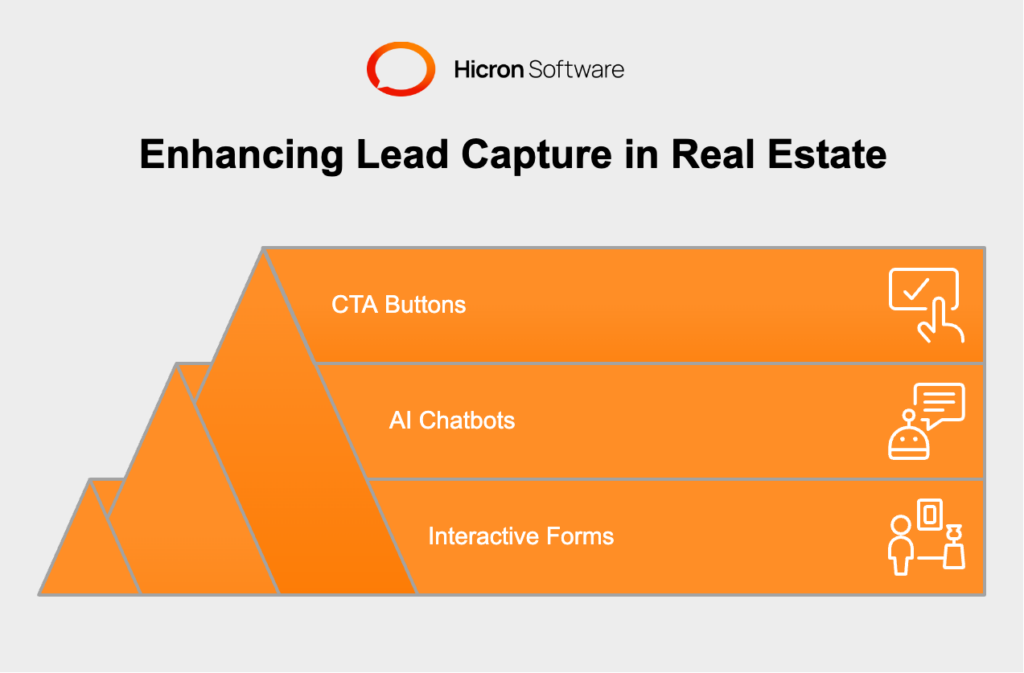
Here are the standout tools transforming how real estate leads are captured:
Interactive forms embedded directly into real estate virtual tours or property listing pages allow professionals to collect valuable buyer information, such as contact details, preferences, and inquiries, without disrupting the buying journey. As buyers explore immersive virtual walkthroughs, they encounter prompts to request more information or schedule a property showing. These forms generate instant opportunities to engage, increasing the likelihood of converting interest into leads.
AI-powered chatbots for real estate sales act as round-the-clock assistants, engaging visitors and capturing leads in real time. These chatbots answer common buyer questions, guide users to specific property features, and collect essential lead data while buyers are exploring real estate virtual tours or browsing listings. Automated interactions ensure no opportunity is missed and response times are kept to a minimum, directly improving the lead capture rate.
Strategically placed call-to-action buttons on websites and within virtual tours encourage potential buyers to take the next step. Whether scheduling a property viewing, booking a virtual consultation, or requesting a callback, these CTAs offer direct ways for buyers to engage with agents and progress further along the purchasing journey.
Integrating lead capturing tools with real estate CRM platforms such as Salesforce, HubSpot, or Zoho enables automatic syncing of captured leads for more effective management and follow-up.
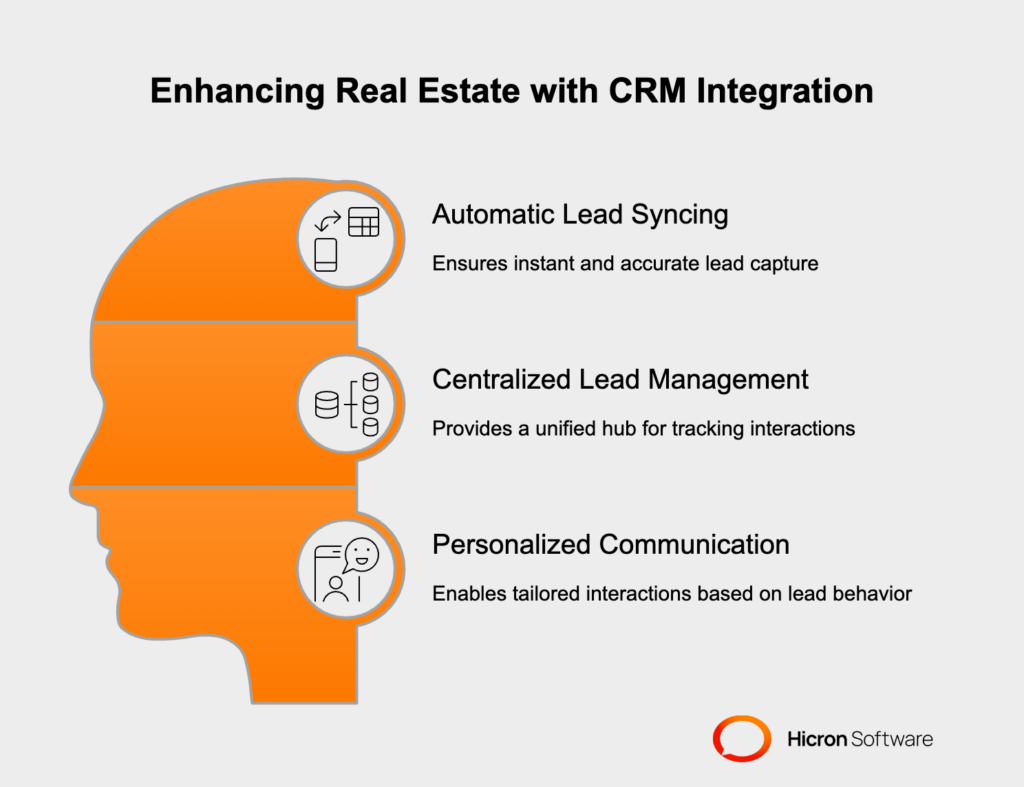
Here’s how CRM integration is supporting real estate professionals:
When a buyer completes a form during a virtual tour or interacts with a chatbot, their information is instantly logged into the chosen real estate CRM platform. This integration ensures all leads are captured accurately, stored securely, and available for immediate follow-up, reducing manual entry and potential errors.
A well-implemented real estate CRM platform provides a centralized hub for tracking all interactions, inquiries, and communication with potential clients. Agents benefit from organized pipelines, prioritized follow-ups, and a holistic view of each prospect’s journey, allowing for more efficient and effective sales processes.
Personalized Communication in Real Estate Sales
Integrating real estate CRM platforms allows for highly personalized communication based on each lead’s behavior and preferences. For example, if a prospect spends considerable time viewing properties in a certain price range within the real estate virtual tours, agents can follow up with tailored property recommendations and relevant updates.
Beyond CRM integration, linking additional business systems multiplies efficiency and market reach. Integrating property management software, marketing automation tools, and analytics platforms creates a unified real estate technology ecosystem:
When interactive sales solutions connect with property management software, real estate firms can keep listing availability, pricing, and details updated across all platforms, including virtual tours. Any status change is immediately reflected, eliminating discrepancies and ensuring buyers always see the latest information.
Connecting marketing automation tools to captured lead data empowers real estate professionals to run highly targeted campaigns. Tools like Mailchimp or Marketo use this information to automatically send new listing alerts, exclusive offers, or open house invitations to carefully segmented audiences, enhancing conversion rates.
Advanced analytics platforms such as Google Analytics or Tableau, when integrated with interactive sales solutions and real estate virtual tours, provide invaluable insights into lead conversion rates and campaign performance. These analytics help real estate professionals identify which marketing strategies are working, understand buyer behavior in virtual environments, and continually improve engagement.
|
System |
Description |
Benefits/Examples |
|
Property Management Software |
Connects interactive sales solutions to property management platforms to keep availability, pricing, and property details updated. |
Reflects listing status changes instantly across real estate virtual tours and online platforms, avoiding discrepancies. |
|
Marketing Automation Tools |
Links lead data with marketing automation tools like Mailchimp or Marketo to create targeted real estate campaigns. |
Sends personalized property alerts and promotions to relevant audience segments to boost engagement and conversion. |
|
Analytics Platforms |
Integrates with analytics platforms such as Google Analytics or Tableau to provide actionable insights. |
Measures lead conversion rates, virtual tour performance, and campaign effectiveness to guide data-driven decisions. |
Lead capturing and system integration in real estate are essential for creating a streamlined, buyer-focused process. With features like
professionals can nurture leads more effectively and deliver a personalized buyer experience. By integrating property management software, marketing automation tools, and analytics platforms, real estate businesses boost operational efficiency and empower smarter marketing strategies.
With these advanced tools in place, real estate professionals can enhance their sales performance, gain a competitive edge, and build lasting relationships with clients. Real estate businesses that invest in innovative solutions today will win the trust and loyalty of tomorrow’s buyers.
Creating interactive real estate sales solutions requires a clear, structured timeline that ensures every phase contributes to delivering a high-performing, user-centric product. From initial research to gathering user feedback, each stage plays a critical role in building robust and innovative real estate technology. Below is a step-by-step breakdown of the development timeline.
|
Phase |
Key Activities |
Objectives/Outcomes |
|
Phase 1: Research and Planning |
|
|
|
Phase 2: Design and Prototyping |
|
|
|
Phase 3: Development and Testing |
|
|
|
Phase 4: Deployment and Feedback |
|
|
The first step in developing real estate sales solutions is building a strong foundation through comprehensive research and strategic planning.
This phase serves as the backbone of development, ensuring the final product aligns with market demands and user expectations.
Once the groundwork is completed, the focus shifts to designing user-friendly interfaces and prototyping potential solutions.
Design and prototyping guarantee that the solution delivers an engaging and efficient user experience while laying the groundwork for successful technological implementation.
With a solid prototype and actionable insights from testing, the next step involves developing the technical infrastructure and verifying its functionality.
Conducting thorough development and testing underscores a commitment to quality, making the platform reliable and ready for real-world use.
The final phase involves introducing the solution to users and continuously refining it based on their input.
By addressing feedback promptly, developers can refine the solution, fixing any shortcomings and building trust with end users. Feedback is also a wellspring for potential updates or new features, ensuring the product continues to evolve alongside market demands.
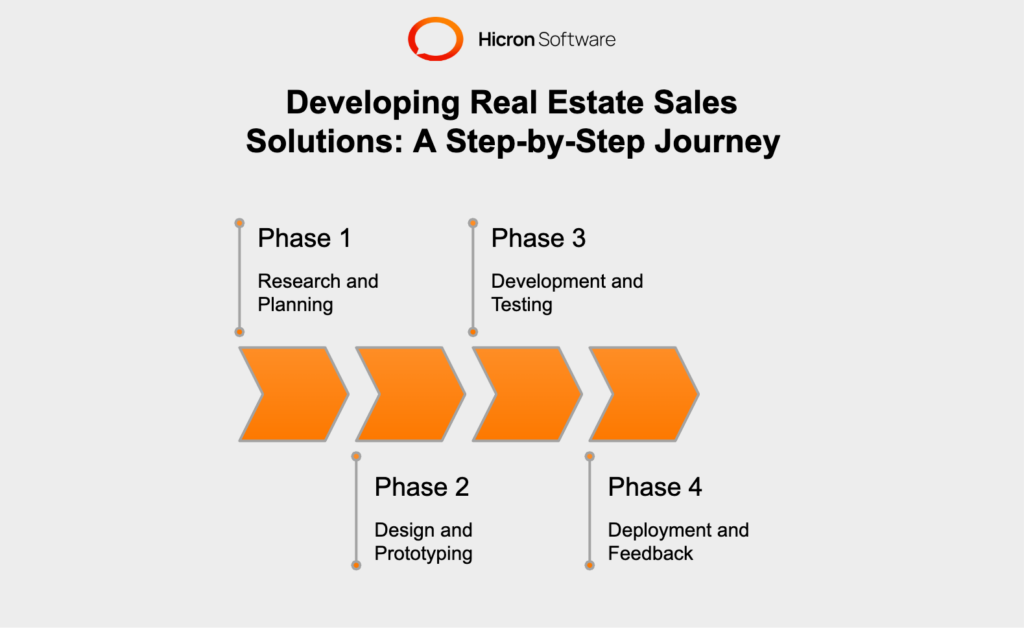
Developing interactive real estate sales solutions is a meticulous process that involves thorough research, innovative design, advanced technology, and continuous improvement. From identifying market needs in Phase 1 to refining the product post-launch in Phase 4, every step matters in bringing a high-performing solution to life.
By following a structured timeline, real estate tech companies can deliver user-friendly, impactful tools that enhance both buyer experiences and sales efficiency, driving success in a competitive market.
Building effective real estate sales solutions requires collaboration among skilled professionals who excel in diverse fields. This specialized team ensures that every aspect of the solution, from design to deployment, is handled with expertise and focus. Here’s a breakdown of the key roles in a real estate technology team and their contributions:
|
Role |
Responsibilities |
Contributions/Examples |
|
Project Manager |
Oversees timelines, budgets, and deliverables. Ensures team communication and alignment with project goals. |
Guarantees development stays on track and aligns with business objectives. Coordinates across all departments. |
|
UI/UX Designers |
Designs user-friendly and visually appealing interfaces. Creates wireframes and interactive layouts focusing on usability. |
Develops intuitive interfaces like interactive virtual tours and customizable floor plans to improve user engagement. |
|
Software Developers |
Builds the core functionalities of the platform. Focuses on coding, system integration, and security. |
Implements features like search engines, AR tools, and CRM integrations. Ensures reliability and scalability of the platform. |
|
Data Analysts |
Analyzes user behavior and market data to drive feature optimization. Transforms raw data into actionable insights. |
Refines platform features based on buyer engagement metrics. Identifies trends to improve user experience and performance. |
Together, this multifaceted team creates robust solutions tailored to the needs of the competitive real estate market.
Behind every innovative real estate sales solution is a combination of cutting-edge technologies designed to enhance functionality, engagement, and scalability. Here are the essential technologies driving interactive real estate platforms:
|
Technology |
Description |
Benefits/Examples |
|
3D Modeling Software |
Tools like Matterport and SketchUp used to create high-resolution, interactive 3D walkthroughs. |
Enables photorealistic virtual tours, realistic sense of space and layout, and supports architectural designs. |
|
Augmented Reality (AR) Platforms |
Platforms such as ARKit, ARCore, and WebAR that allow users to visualize property changes and enhancements in real time. |
Allows buyers to project furniture, preview renovations, and customize spaces before purchase. |
|
Cloud Computing for Real Estate |
Scalable cloud infrastructure for data storage, virtual tour hosting, and property update syncing. |
Ensures fast and reliable access to data, supports global buyer reach, and secures sensitive user information. |
|
AI and Machine Learning |
Technologies for analyzing buyer preferences and forecasting market trends based on data. |
Delivers personalized property suggestions, provides predictive analytics, and enhances lead engagement with chatbots. |
|
API Integrations |
Connects sales solutions with CRMs, marketing tools, and other systems for data sharing. |
Automates lead management, synchronizes buyer interactions, and enables targeted marketing campaigns. |
3D modeling tools such as Matterport and SketchUp are critical for creating immersive property experiences. These platforms produce high-resolution, interactive 3D walkthroughs, allowing buyers to explore properties remotely. For example, Matterport provides photorealistic virtual tours that mimic in-person visits, while SketchUp supports the creation of detailed architectural designs. These tools bring properties to life by providing buyers with a realistic sense of space and layout.
By integrating 3D modeling for real estate, platforms help sellers showcase properties effectively and give buyers the confidence to make informed decisions, even from afar.
Augmented reality platforms like ARKit, ARCore, and WebAR allow buyers to visualize changes to a property in real time. Using a smartphone or tablet, users can project virtual furniture into empty rooms, experiment with color schemes, or preview renovations. This level of customization empowers buyers by enabling them to picture themselves living in a space before making a purchase.
For sellers, AR transforms the staging and presentation process. Builders can use AR to showcase unfinished properties while helping buyers imagine their future homes.
Cloud computing provides the scalability and flexibility real estate platforms need to handle large volumes of data. Cloud infrastructure powers data storage, virtual tour hosting, and property update syncing across platforms. It ensures that buyers can access listings without slowdowns, even during periods of heavy traffic.
Cloud technology also supports multi-region availability, making property information accessible to global buyers. With secure data storage solutions, it safeguards sensitive customer and transaction data, earning trust from users.
Artificial intelligence and machine learning redefine personalization and decision-making in real estate sales. These technologies analyze user preferences, browsing behavior, and historical data to deliver tailored property suggestions. AI chatbots also enhance communication by addressing buyer inquiries instantly, improving lead generation and engagement.
Machine learning enables predictive analytics, forecasting market trends or property demands. For example, AI in real estate sales can predict which listings are likely to sell quickly, helping agents prioritize efforts effectively.
API integrations are the glue that connects interactive sales solutions with external platforms, such as real estate CRMs or marketing software. These integrations allow data sharing across systems, enabling features like synchronized lead management, automated follow-ups, and analytics reporting.
For instance, integrating a CRM like Salesforce with a real estate platform ensures buyer interactions during virtual tours are logged automatically. APIs also connect marketing tools, like email automation software, to target leads based on their activity within the platform.
These solutions streamline operations and enhance the buyer experience, driving engagement. Whether you’re a developer, agent, or broker, leveraging these innovations is the key to long-term success in real estate.
Customization is rapidly becoming the key differentiator in the competitive real estate market. Buyers expect meaningful, tailored experiences that address their unique needs, and firms that adapt their solutions strategically can set themselves apart. Custom real estate interactive sales solutions enhance the buyer experience and unlock new opportunities for scaling and innovating in diverse markets.
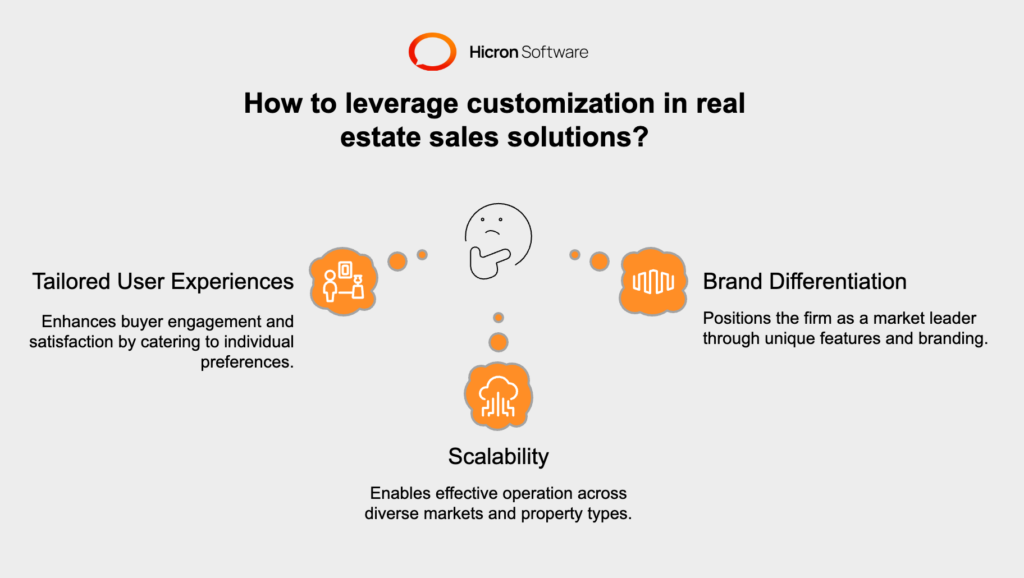
Custom interactive real estate sales solutions are designed to cater to the unique preferences and expectations of individual buyers. Unlike generic platforms, they enable personalization, leading to higher engagement and satisfaction.
For instance, buyers seeking luxury properties are likely to prioritize detailed virtual tours, high-definition imagery, and specially curated property listings. On the other hand, first-time buyers may benefit from features such as affordability calculators, mortgage guidance, and educational resources.
Well-designed custom solutions leverage analytics and AI to present buyers with tailored content based on their browsing behavior, budget, and interests.
A prime example is platforms that allow visitors to customize their search criteria with granular filters, such as school district ratings or proximity to transit options. These personalized tools empower buyers to find properties that align with their specific requirements, thereby reducing frustration and streamlining the decision-making process.
Customization also drives brand differentiation, giving firms a unique edge over competitors. By incorporating exclusive features and cutting-edge technology into their platforms, businesses can position themselves as market leaders.
Features like augmented reality, AR-enabled property tours, or AI-powered chatbots for instant customer support are still not widely adopted across the industry. By offering these advanced customizations, a real estate company can stand out as a tech-forward brand.
Custom branding within the platform itself is another key area of differentiation. Creating a cohesive design language, including colors, typography, and logos aligned with the firm’s visual identity, reinforces brand recognition. When buyers associate these branded features with premium services and usability, it fosters loyalty and sets the business apart in a crowded marketplace.
Ultimately, delivering unique value through customization strengthens buyer trust while positioning the company as an innovator.
Customization doesn’t just cater to buyer-specific needs. It supports scalability, enabling real estate businesses to operate effectively across different property types, markets, and buyer demographics.
Scalable real estate technology ensures that features can adapt to the diverse demands of a growing portfolio. For example, a platform built for residential properties can be customized to serve the commercial market by integrating features like space planning tools and ROI calculators. Similarly, geo-targeting features make it possible to tailor the platform for local markets, helping businesses enter new regions without a complete system overhaul.
Additionally, cloud-based custom solutions allow businesses to scale their operations smoothly. Whether it’s managing a spike in users during peak seasons or expanding data capabilities to include more property listings, flexible infrastructure ensures that growth. Businesses that invest in scalable technology reduce downtime, limit disruption, and improve their ability to meet the needs of a dynamic market.
Interactive sales solutions are transforming the real estate industry by redefining how properties are marketed and sold. These technologies enhance buyer engagement through immersive experiences, such as virtual tours and augmented reality, making it easier for clients to visualize properties and make informed decisions. At the same time, they streamline operations for real estate professionals by automating processes, integrating analytics, and creating user-friendly platforms, ultimately driving business growth.
Customization stands out as a pivotal strategy in leveraging these tools effectively. By tailoring solutions to meet specific buyer needs, real estate businesses gain a competitive edge in an increasingly dynamic market. Personalized features, scalable platforms, and unique innovations allow firms to differentiate themselves, build brand loyalty, and respond to market trends with agility.
Now is the time to take your real estate business to the next level. Build custom interactive sales solutions and discover how they can elevate your operations, boost client satisfaction, and secure your position at the forefront of the industry. Invest in innovation and watch your business transform into a leader in real estate technology. Get in touch!
Interactive sales solutions are technology-driven platforms that enhance property marketing and streamline sales processes. They include tools like virtual tours, 3D walkthroughs, augmented reality, and CRM integrations to provide immersive and efficient experiences for buyers and agents.
These solutions offer features like virtual tours and augmented reality, allowing buyers to explore properties remotely, customize layouts, and visualize design changes. This creates a more engaging and personalized experience, helping buyers make informed decisions faster.
Customization allows businesses to tailor solutions to meet diverse buyer needs, differentiate their brand, and provide unique features. It also supports scalability, enabling platforms to adapt to various property types and markets.
By automating repetitive tasks like lead management and follow-ups, and integrating with CRM systems, these solutions allow agents to focus on building client relationships and closing deals faster.
Embedded analytics provide insights into buyer behavior, such as property engagement trends and feature preferences. This helps agents refine marketing strategies, personalize recommendations, and optimize sales processes.
These solutions position businesses as industry leaders by offering innovative tools that align with modern buyer expectations. Features like branded virtual tours and real-time communication foster trust, loyalty, and a competitive edge.
